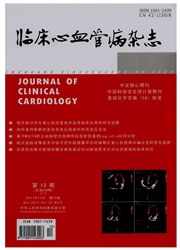

 中文摘要:
中文摘要:
目的:探讨循环单核细胞亚群联合肾功能对急性ST段抬高心肌梗死(ST segment elevation myocardial infarction,STEMI)患者预后危险分层的评估。方法:入选发病后接受急诊冠状动脉介入治疗(percutaneous coronary intervention,PCI)的初次STEMI患者。于入院第2天抽取患者外周血进行单核细胞亚群[经典型(CD14^++CD16^-,Mon1)、中间型(CD14^++CD16^+,Mon2)和非经典型(CD14+CD16^++,Mon3)]流式细胞术分析。随访患者3年内主要不良心血管事件(major adverse cardiovascular events,MACE)的发生情况。采用COX比例风险模型分析循环单核细胞亚群水平及肾功能与MACE的关系。根据循环单核细胞亚群及肾功能不全的最佳截断值对STEMI患者进行危险分层,采用Kaplan-Meier生存分析法比较各危险分层的无事件生存率。结果:3年随访221例患者中有50例发生MACE(MACE组)。与非MACE组患者相比,MACE组患者年龄更大、Mon2计数水平更高,差异具有统计学意义(P=0.009和P〈0.001);估测肾小球滤过率(estimated glomerular filtration rate,eGFR)、左心室射血分数值更低(P=0.01和P〈0.001)。多变量COX回归分析显示,校正了传统危险因素后,Mon2〉32.1cells/μl(HR2.33,95%CI 1.24~4.38,P=0.008)、eGFR〈60 ml·min~(-1)·1.73m~(-2)(HR2.43,95%CI1.01~5.85,P=0.048)是STEMI患者发生MACE的独立危险因素。以eGFR的临界值60ml·min~(-1)·1.73m~(-2)、Mon2的最佳截断值32.1cells/μl对STEMI患者进行为危险分层,相对于低危组,中危组患者发生MACE的风险增加了2.00倍(95%CI 1.65~5.30,P〈0.001),高危组患者发生MACE的风险增加了3.37倍(95%CI2.44~11.5,P〈0.01)。Kaplan-Meier生存分析结果同上述一致。结论:循环单核细胞Mon2联合eGFR能够预测STEMI患者3年内MACE的发生,具有潜在临床应用价值。
 英文摘要:
英文摘要:
peripheral blood was collected on day 2of STEMI onset for flow cytometry(FCM)analysis of circulation monocyte subsets[classical CD14^++CD16^-(Mon1),intermediate CD14^++CD16^+(Mon2),and nonclassical CD14+CD16^++(Mon3)].Major adverse cardiac events(MACE)were followed for 3years. Cumulative survival rates stratified by monocyte subset count and renal function categories were estimated using Kaplan-Meier survival analysis and Cox proportional hazards regression model.Result:During a median follow-up of three years,among 211 STEMI cases recruited,50 first MACE were recorded.Compared with patients without MACE,the patients with MACE were older,more likely to have high Mon2 monocyte count(P=0.09 and P〈0.001),and along with lower eGFR and left ventricular ejection fraction(LVEF)(P=0.01 and P〈0.001).After adjustment of conventional risk factors,Mon2 monocyte count and renal insufficiency remained to be the independent predictive factor of MACE:HR2.33,95%CI 1.24-4.38,P=0.008 and HR2.43,95%CI1.01-5.85,P=0.048,respectively.According to stratification of Mon2 monocyte count in combination with renal insufficiency,the patients were divided into low-,intermediate-,and high-risk groups.Compared with the low-risk group,the risk of MACE increased 2.00times(95%CI 1.65-5.30,P〈0.001)in the patients of intermediate-risk group,and the risk increased 4.37times(95%CI2.44-11.48,P〈0.01)in the patients of high-risk group.Kaplan-Meier Survival Analysis supports the above results.Conclusion:Mon2monocyte and renal insufficiency are independent risk factors for predictor of MACE,which has potential clinical value.
 同期刊论文项目
同期刊论文项目
 同项目期刊论文
同项目期刊论文
 期刊信息
期刊信息
